The Windows Warning Alert is a misleading web-site that can be used to trick you into calling the fake Microsoft Support Service or redirect the Chrome, Internet Explorer, Mozilla Firefox and MS Edge to other misleading and malicious pages. If your browser constantly displays the “Windows Warning Alert” page, then this might be a sign that the personal computer is affected by a PUP (potentially unwanted program) from the adware family. Most often, the unwanted program installs on the PC in abundle with free programs that you downloaded and installed from the Internet. Once it gets inside your computer, it’ll modify some personal computer’s home page, new tab page and search engine by default in order to redirect your’s browser to ad web-sites or show tons of annoying pop-up ads from various third-party ad networks.
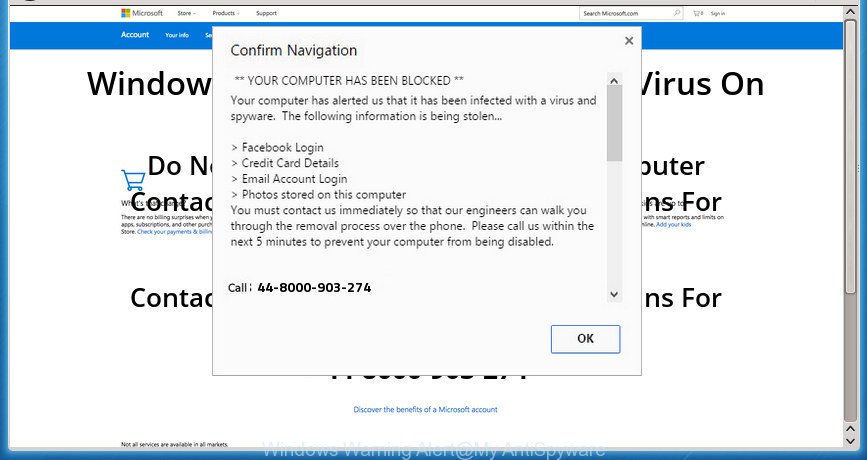
“Windows Warning Alert” is a misleading advertising
It’s likely that you might be bothered with the ‘ad supported’ software which developed to show misleading “Windows Warning Alert” popup scam within your browser. You should not disregard this unwanted software. The ‘ad supported’ software might not only display annoying advertisements, but redirect your browser to malicious web-sites. What is more, the ad supported software can analyze your surfing, and gain access to your user information and, afterwards, can transfer it to third parties. Thus, there are more than enough reasons to remove “Windows Warning Alert” pop up from your computer.
Most often, the adware affects the most common internet browsers like the Chrome, Firefox, MS Edge and Microsoft Internet Explorer. But such the malicious software as well may infect another web-browsers by changing its shortcuts (adding an argument such as ‘http://site.address’ into Target field of a browser’s shortcut). So every time you open the internet browser, it will reroute to the unwanted “Windows Warning Alert” site. Even if you setup a new startpage, an annoying web-site will be the first thing you see when you launch the Firefox, Google Chrome, Internet Explorer and Microsoft Edge.
So, obviously, you need to delete the adware as quickly as possible. Use the free step by step tutorial below. This guide will allow you clean your system of adware and thereby remove the “Windows Warning Alert” intrusive ads.
How to remove “Windows Warning Alert” popup warnings
Fortunately, it is not hard to remove adware that causes misleading “Windows Warning Alert” pop-up scam on your browser. In the following guide, we will provide two ways to clean your computer of this adware. One is the manual removal solution and the other is automatic removal way. You can choose the way that best fits you. Please follow the removal tutorial below to remove “Windows Warning Alert” fake alerts right now!
To remove “Windows Warning Alert”, perform the steps below:
- How to get rid of “Windows Warning Alert” fake alerts without any software
- Remove potentially unwanted software using Windows Control Panel
- Remove unwanted Scheduled Tasks
- Clean up the internet browsers shortcuts which have been hijacked by adware
- Remove “Windows Warning Alert” pop-up from Internet Explorer
- Remove “Windows Warning Alert” fake alerts from Google Chrome
- Get rid of “Windows Warning Alert” pop-up warnings from Firefox
- How to automatically get rid of “Windows Warning Alert” pop-up warnings
- How to stop “Windows Warning Alert” fake alerts
- How to prevent “Windows Warning Alert” pop up from getting inside your machine
- To sum up
How to get rid of “Windows Warning Alert” fake alerts without any software
If you perform exactly the step by step guide below you should be able to remove the “Windows Warning Alert” fake alerts from the Chrome, Firefox, Microsoft Internet Explorer and Microsoft Edge web-browsers.
Remove potentially unwanted software using Windows Control Panel
First, you should try to identify and uninstall the program that causes the appearance of unwanted advertisements or web-browser redirect, using the ‘Uninstall a program’ which is located in the ‘Control panel’.
Windows 8, 8.1, 10
First, click Windows button

After the ‘Control Panel’ opens, click the ‘Uninstall a program’ link under Programs category as displayed in the following example.

You will see the ‘Uninstall a program’ panel as displayed below.

Very carefully look around the entire list of apps installed on your PC. Most probably, one of them is the ad-supported software which causes misleading “Windows Warning Alert” popup warnings on your browser. If you’ve many apps installed, you can help simplify the search of harmful apps by sort the list by date of installation. Once you’ve found a questionable, unwanted or unused program, right click to it, after that click ‘Uninstall’.
Windows XP, Vista, 7
First, click ‘Start’ button and select ‘Control Panel’ at right panel as shown on the screen below.

Once the Windows ‘Control Panel’ opens, you need to click ‘Uninstall a program’ under ‘Programs’ as shown in the figure below.

You will see a list of apps installed on your PC system. We recommend to sort the list by date of installation to quickly find the applications that were installed last. Most probably, it is the adware which shows misleading “Windows Warning Alert” pop up warnings on your computer. If you are in doubt, you can always check the program by doing a search for her name in Google, Yahoo or Bing. After the program which you need to remove is found, simply press on its name, and then click ‘Uninstall’ as displayed on the screen below.

Remove unwanted Scheduled Tasks
Once installed, the ad-supported software can add a task in to the Windows Task Scheduler Library. Due to this, every time when you boot your machine, it will display “Windows Warning Alert” intrusive page. So, you need to check the Task Scheduler Library and delete all harmful tasks which have been created by adware.
Press Windows and R keys on the keyboard simultaneously. This shows a prompt that titled with Run. In the text field, type “taskschd.msc” (without the quotes) and click OK. Task Scheduler window opens. In the left-hand side, click “Task Scheduler Library”, as displayed below.
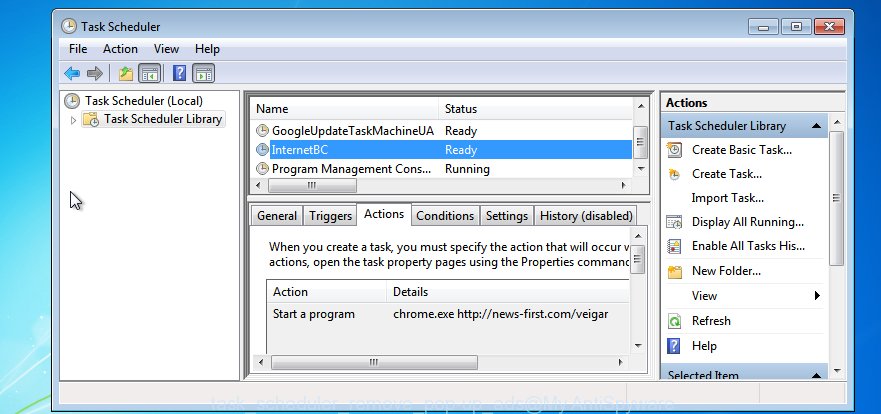
Task scheduler
In the middle part you will see a list of installed tasks. Please select the first task, its properties will be show just below automatically. Next, click the Actions tab. Pay attention to that it launches on your machine. Found something like “explorer.exe http://site.address” or “chrome.exe http://site.address”, then delete this harmful task. If you are not sure that executes the task, check it through a search engine. If it is a component of the malicious program, then this task also should be removed.
Having defined the task that you want to remove, then click on it with the right mouse button and select Delete as displayed in the following example.

Delete a task
Repeat this step, if you have found a few tasks which have been created by unwanted software. Once is finished, close the Task Scheduler window.
Clean up the internet browsers shortcuts which have been hijacked by adware
Important to know, most antimalware programs that are able to delete adware that displays misleading “Windows Warning Alert” pop-up scam on your computer, but unable to detect and recover changed shortcuts. So, you need to fix the desktop shortcuts for your Chrome, Mozilla Firefox, IE and Edge web browsers manually.
Right click on the shortcut file of infected web-browser as on the image below.
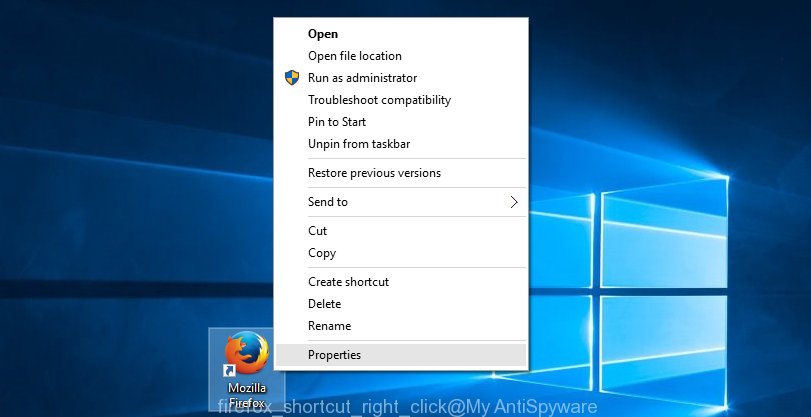
Select the “Properties” option and it will show the shortcut’s properties. Next, click the “Shortcut” tab and then delete the “http://site.address” string from Target field as shown on the image below.
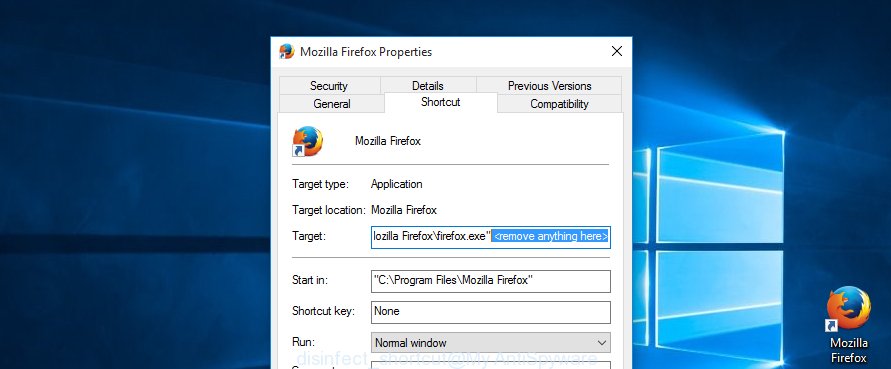
Then click OK to save changes. Repeat the step for all web browsers which are rerouted to the “Windows Warning Alert” undesired web-site.
Remove “Windows Warning Alert” pop-up from Internet Explorer
The Microsoft Internet Explorer reset is great if your web browser is hijacked or you have unwanted addo-ons or toolbars on your browser, that installed by an malicious software.
First, start the Internet Explorer, then press ‘gear’ icon ![]() . It will open the Tools drop-down menu on the right part of the web browser, then click the “Internet Options” as shown in the following example.
. It will open the Tools drop-down menu on the right part of the web browser, then click the “Internet Options” as shown in the following example.

In the “Internet Options” screen, select the “Advanced” tab, then click the “Reset” button. The Internet Explorer will show the “Reset Internet Explorer settings” dialog box. Further, press the “Delete personal settings” check box to select it. Next, click the “Reset” button like below.

Once the process is done, press “Close” button. Close the Internet Explorer and restart your computer for the changes to take effect. This step will help you to restore your browser’s new tab page, startpage and search engine by default to default state.
Remove “Windows Warning Alert” fake alerts from Google Chrome
Reset Chrome settings is a easy way to get rid of the browser hijackers, malicious and ‘ad-supported’ extensions, as well as to recover the web browser’s home page, new tab page and search engine by default that have been replaced by adware that causes misleading “Windows Warning Alert” pop up on your web browser.
First start the Chrome. Next, press the button in the form of three horizontal dots (![]() ).
).
It will show the Google Chrome menu. Choose More Tools, then click Extensions. Carefully browse through the list of installed plugins. If the list has the plugin signed with “Installed by enterprise policy” or “Installed by your administrator”, then complete the following tutorial: Remove Chrome extensions installed by enterprise policy.
Open the Google Chrome menu once again. Further, click the option named “Settings”.

The browser will open the settings screen. Another method to show the Google Chrome’s settings – type chrome://settings in the browser adress bar and press Enter
Scroll down to the bottom of the page and click the “Advanced” link. Now scroll down until the “Reset” section is visible, like below and click the “Reset settings to their original defaults” button.

The Google Chrome will open the confirmation prompt as on the image below.

You need to confirm your action, press the “Reset” button. The web-browser will launch the process of cleaning. Once it is done, the web browser’s settings including startpage, newtab and search provider by default back to the values which have been when the Google Chrome was first installed on your computer.
Get rid of “Windows Warning Alert” pop-up warnings from Firefox
Resetting your Firefox is basic troubleshooting step for any issues with your internet browser application, including the redirect to “Windows Warning Alert” web page.
First, open the Mozilla Firefox. Next, press the button in the form of three horizontal stripes (![]() ). It will show the drop-down menu. Next, press the Help button (
). It will show the drop-down menu. Next, press the Help button (![]() ).
).

In the Help menu click the “Troubleshooting Information”. In the upper-right corner of the “Troubleshooting Information” page click on “Refresh Firefox” button like below.

Confirm your action, press the “Refresh Firefox”.
How to automatically get rid of “Windows Warning Alert” pop-up warnings
The adware can hide its components which are difficult for you to find out and remove completely. This can lead to the fact that after some time, the adware that displays misleading “Windows Warning Alert” pop up warnings on your computer once again infect your computer. Moreover, We want to note that it’s not always safe to remove adware manually, if you do not have much experience in setting up and configuring the Windows operating system. The best solution to find out and get rid of ad-supported software is to use free malware removal apps.
How to automatically remove “Windows Warning Alert” pop-up warnings with Zemana Anti-malware
We recommend you to run the Zemana Anti-malware which are completely clean your machine of adware which developed to display misleading “Windows Warning Alert” pop-up scam within your web browser. Moreover, the tool will help you to get rid of PUPs, malware, toolbars and browser hijackers that your personal computer may be infected too.
Download Zemana Anti-Malware (ZAM) from the link below. Save it on your Windows desktop or in any other place.
164705 downloads
Author: Zemana Ltd
Category: Security tools
Update: July 16, 2019
When the downloading process is finished, start it and follow the prompts. Once installed, the Zemana Anti-Malware will try to update itself and when this procedure is complete, click the “Scan” button to perform a system scan for the adware that cause misleading “Windows Warning Alert” popup scam to appear.

This process can take quite a while, so please be patient. When a threat is detected, the number of the security threats will change accordingly. Wait until the the checking is finished. When you are ready, click “Next” button.

The Zemana Anti Malware will start to remove adware which displays misleading “Windows Warning Alert” pop-up scam on your PC.
Use Malwarebytes to remove “Windows Warning Alert” popup scam
We recommend using the Malwarebytes Free that are completely clean your computer of the adware. The free utility is an advanced malicious software removal program designed by (c) Malwarebytes lab. This program uses the world’s most popular anti malware technology. It is able to help you remove annoying “Windows Warning Alert” popup scam from your web-browsers, potentially unwanted programs, malicious software, browser hijacker infections, toolbars, ransomware and other security threats from your PC system for free.
Please go to the following link to download MalwareBytes Free. Save it on your Microsoft Windows desktop or in any other place.
326984 downloads
Author: Malwarebytes
Category: Security tools
Update: April 15, 2020
Once the download is finished, close all applications and windows on your computer. Double-click the setup file called mb3-setup. If the “User Account Control” dialog box pops up as shown on the screen below, click the “Yes” button.

It will open the “Setup wizard” which will help you set up MalwareBytes Free on your computer. Follow the prompts and don’t make any changes to default settings.

Once setup is done successfully, press Finish button. MalwareBytes Free will automatically start and you can see its main screen as shown on the image below.
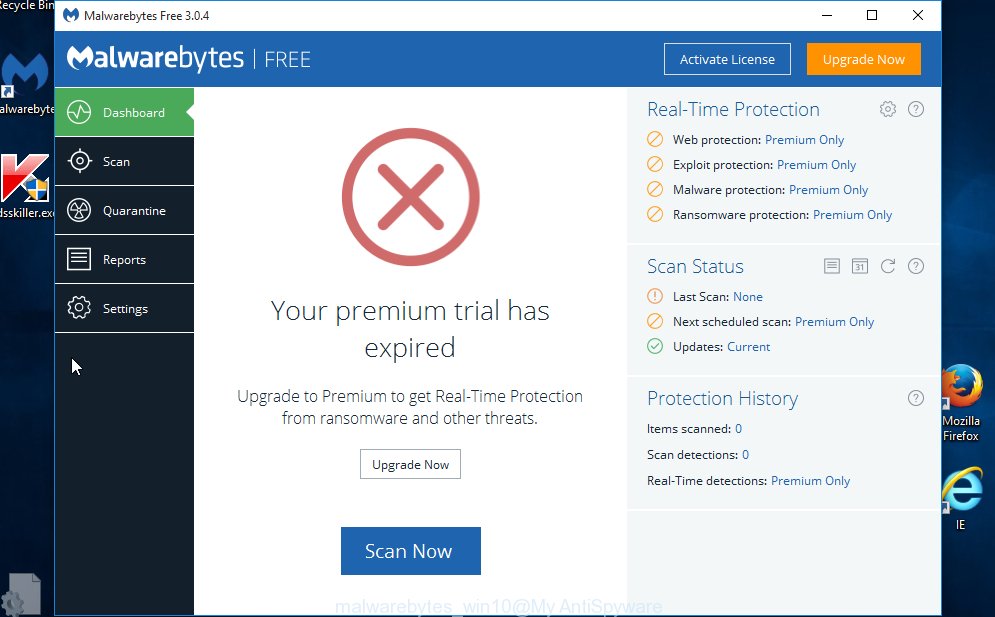
Now click the “Scan Now” button .MalwareBytes Free program will scan through the whole computer for the ad supported software that causes multiple misleading “Windows Warning Alert” alerts and pop-ups. This process can take some time, so please be patient. During the scan MalwareBytes Anti Malware (MBAM) will detect threats present on your computer.
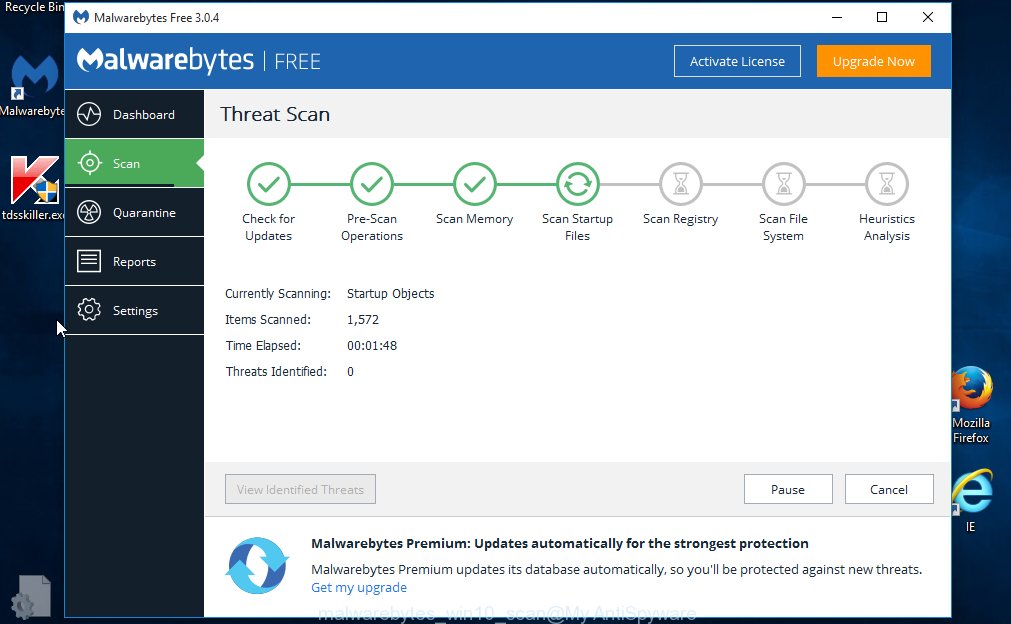
As the scanning ends, you may check all threats found on your personal computer. Review the scan results and then click “Quarantine Selected” button. The MalwareBytes Free will remove adware that cause misleading “Windows Warning Alert” fake alerts to appear and add items to the Quarantine. When finished, you may be prompted to restart the computer.
We recommend you look at the following video, which completely explains the process of using the MalwareBytes Anti-Malware (MBAM) to delete adware, hijacker and other malware.
Use AdwCleaner to delete “Windows Warning Alert” pop-up
AdwCleaner is a free utility which can identify ‘ad supported’ software that displays misleading “Windows Warning Alert” popup on your computer. It’s not always easy to locate all the unwanted software that your computer might have picked up on the World Wide Web. AdwCleaner will scan for the ad-supported software, hijackers and other malicious software you need to erase.
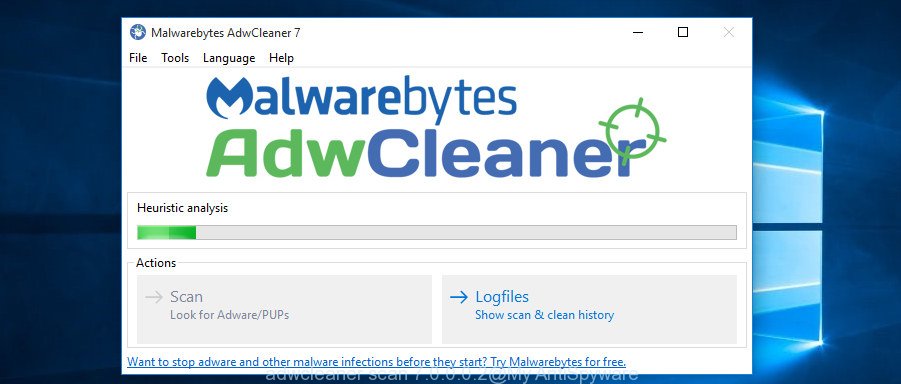
- Click the following link to download AdwCleaner. Save it on your Windows desktop.
AdwCleaner download
225504 downloads
Version: 8.4.1
Author: Xplode, MalwareBytes
Category: Security tools
Update: October 5, 2024
- Select the directory in which you saved it as Desktop, and then press Save.
- When downloading is finished, start the AdwCleaner, double-click the adwcleaner_xxx.exe file.
- If the “User Account Control” prompts, press Yes to continue.
- Read the “Terms of use”, and click Accept.
- In the AdwCleaner window, click the “Scan” to scan for adware that displays misleading “Windows Warning Alert” popup on your computer. A scan may take anywhere from 10 to 30 minutes, depending on the number of files on your machine and the speed of your personal computer. During the scan AdwCleaner will find threats exist on your PC.
- Once AdwCleaner completes the scan, a list of all threats detected is produced. In order to get rid of all threats, simply click “Clean”. If the AdwCleaner will ask you to reboot your machine, press “OK”.
The steps shown in detail in the following video.
How to stop “Windows Warning Alert” fake alerts
In order to increase your security and protect your computer against new unwanted ads and malicious web pages, you need to run ad blocker application that blocks an access to harmful ads and web-pages. Moreover, the program can stop the open of intrusive advertising, which also leads to faster loading of web sites and reduce the consumption of web traffic.
Installing the AdGuard ad blocker program is simple. First you’ll need to download AdGuard on your Microsoft Windows Desktop from the following link.
26819 downloads
Version: 6.4
Author: © Adguard
Category: Security tools
Update: November 15, 2018
After downloading is finished, double-click the downloaded file to run it. The “Setup Wizard” window will show up on the computer screen as shown on the image below.

Follow the prompts. AdGuard will then be installed and an icon will be placed on your desktop. A window will show up asking you to confirm that you want to see a quick guidance as on the image below.

Click “Skip” button to close the window and use the default settings, or click “Get Started” to see an quick guidance that will help you get to know AdGuard better.
Each time, when you launch your PC, AdGuard will run automatically and block popup ads, web-sites such “Windows Warning Alert”, as well as other harmful or misleading web-pages. For an overview of all the features of the application, or to change its settings you can simply double-click on the AdGuard icon, which is located on your desktop.
How to prevent “Windows Warning Alert” pop up from getting inside your machine
The ad-supported software gets on your computer as a part of various free software. This means that you need to be very careful when installing programs downloaded from the Net, even from a large proven hosting. Be sure to read the Terms of Use and the Software license, select only the Manual, Advanced or Custom setup method, switch off all additional modules and applications are offered to install.
To sum up
Once you have complete the few simple steps above, your computer should be free from ‘ad supported’ software that displays misleading “Windows Warning Alert” pop up on your PC system and other malicious software. The Chrome, Mozilla Firefox, IE and Edge will no longer redirect you to various intrusive web sites like “Windows Warning Alert”. Unfortunately, if the step-by-step guidance does not help you, then you have caught a new ad-supported software, and then the best way – ask for help in our Spyware/Malware removal forum.




















